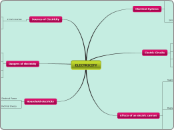ELECTRICITY
Electrical Systems
Made up of parts that work together to perform a function
Electrical Components
Inputs and Outputs
Input; e.g switch
Output; e.g lightbulb
Simple electrical systems will consist of
connecting wires
lightbulb
switch
electric cells
Electric Circuits
Resistance
occurs when electrical components act as an obstacle against the flow of electrons
Measured with Reseistors
SI unit: Ohm (Ω)
Current
The flow of electrons in one direction in a circuit
Measured with Ammeter
SI unit: Ampere (A)
Potential Difference
Amount of potential energy that is changed into other forms of energy when an electron passes between two points
Measured with Voltmeter
SI unit: Volt (V)
Represented by Circuit Symbols
Effects of an electric current
Heating effect
Electrical Energy -> Heat Energy
Applications of heating effect
Kettles, Toasters, Irons, etc
has a heating 'element' inside of appliance which becomes very hot when current flows through
Magnetic effect
Electrical Energy -> Magnetic Force
Applications of magnetic effect
Magnetic Cranes
able to separate iron&steel objects and non-magnetic materials using its powerful electromagnets
Electric Bells
the electromagnet inside the bell switches on and off very quickly, causing a hammer to vibrate, thus hitting the metal gong which produces the sound of the bell
Electric Motors
a machine that converts electrical energy into kinetic energy
Vacuum cleaners, electric trains, fans, etc
Chemical effect
Produces new compounds/ causes compounds to break down
Electroplating
A metallic object is covered with a thin layer of another metal
Electrolysis
The decomposition of a compound by an electric current
Reactive metals, such as sodium and aluminum, can be obtained. A solid compound of the metal is heated until it melts. An electric will then be passed through the molten compound which will break down to give the reactive metals.
Sources of Electricity
2 main sources
Mains electricity
Mains electricity is generated in power stations and supplies a lot of electrical energy. It can give us a electric shock that can kill us. It is delivered to homes and factories through wires and finally to a connection point in the wall called the mains socket.
Electric cells
Electric cells supplies only a small amount of energy. They are safe to touch and used in many portable devices
Dangers of electricity
Overloading
This can cause a fire in the house wiring or the adaptor
Wet Conditions
If a damaged wire or appliance was touched with wet hands, an electric current may flow through the body and get an electric shock
Short Circuits
May cause a fire in the wires or appliance
Frayed and damaged wired
If someone touches a bare wire, current will flow through the body, resulting in an electric shock
Household electricity
Electrical Power
the rate at which electrical energy is converted into other forms of energy
SI unit: Watt (W)
Electrical Energy
Household unit: Kilowatt-hour (kWh)
SI unit: Joule (J)
